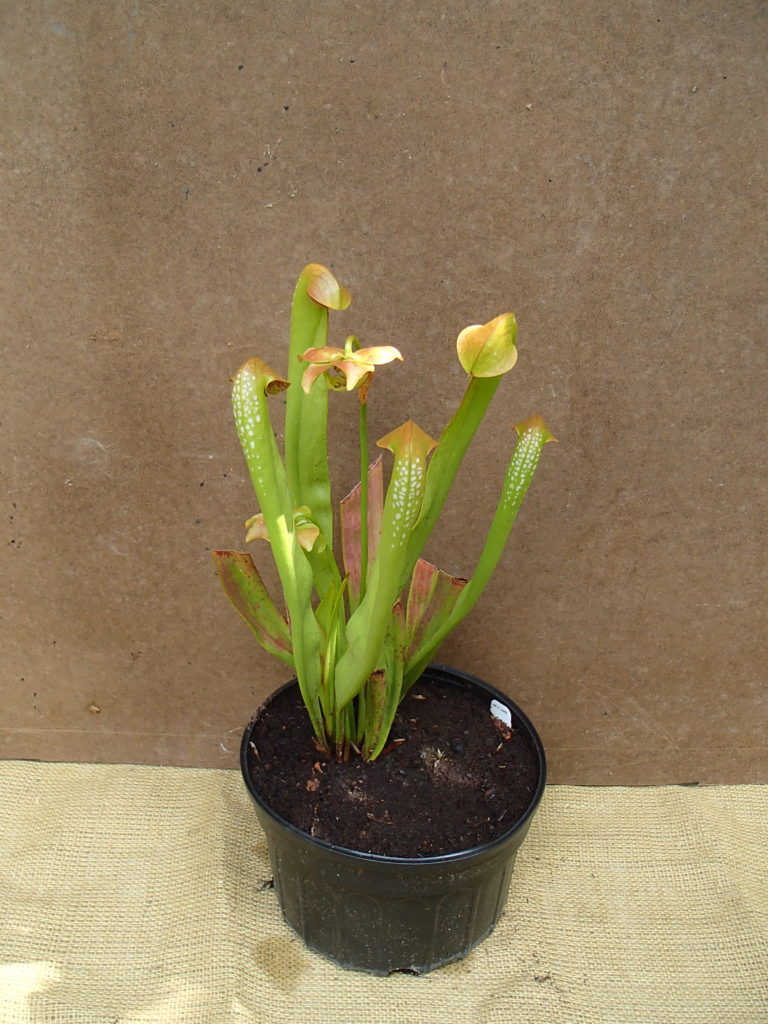The Hooded Pitcherplant, native to the bogs of NC, SC, GA and FL, is a smallish pitcherplant, 8-16 inches tall. The pitcher consists of a green tube or trap which expands gradually from base up towards the hood; then, in an unbroken line, the hood arches smoothly, closely and protectively over the orifice of the trap. There are pronounced white and/or translucent, window-like “panes” on the back of the hood and upper trap. These “fenestrations” permit light to enter the otherwise dark interior of the trap, possibly helping to lure in the critters. In April and May, a round, clear yellow, odorless flower drops from a leafless scape or flower stalk, generally shorter than the pitcher. While the pitcher of S. minor is distinctive, it is similar to other pitcherplants in its habit of pitchers arising as a rosette from a base, spreading by means of rhizomes and being effective at trapping and digesting nitrogenous nourishment from the soft parts of small insect bodies, especially ants. In cultivation it is somewhat drier than others of its family, but if grown in a container it still requires to be kept moist with deionized water and exposed to cold winter temperatures as well.
NURSERY HOURS
Wednesday: 10-4 Thursday: 10-6 Friday-Saturday: 10-4 Sunday: 12-4
Sarracenia minor

Key Info
Scientific Name: Sarracenia minor Walter
Common Names: Hooded Pitcherplant
Family Names: Sarraceniaceae
Light Requirement: Full sun
Flower Color: Yellow
Additional Info
Habit: Sarracenias are clump-forming herbaceous perennials that grow as rosettes from a branching rhizome, forming colonies and containing fibrous roots 8-12 inches long along its length. The pitchers are modified leaves that (in addition to their function of photosynthesis) attract and entrap their insect prey by means of colorful presentation and nectar production (like flowers) and modifications to prevent escape. Wikipedia has a concise treatment of Sarracenia's entrapment mechanisms.
Height: 1'- 1.5'
Spread: 1'
Soil Conditions: Moist or wet, nutrient-poor, peaty, acidic soils.
Leaves: The pitchers are leaves modified to attract, capture, hold and digest animal prey. A pitcher of S. minor is composed of a bright green tube or trap that widens near the top, supporting a deeply recurved hood protecting the orifice, usually in muted accents of red pigment. In addition, the hood and upper trap are dotted with white spots, and show distinctive "fenestrations" which transmit light into the trap.
Flowers (or reproductive structures: Obovate or strap-shaped yellow petals hang down from this inverted umbrella-like, odorless flower, dangling from a leafless scape (stalk) at the same hight or lower than the pitchers.
Fruit: Each flower is followed by a dry 5-parted seed capsule that splits open along 5 seams at maturity (June/July) exposing small, papery, pear-shaped seeds. The seeds fall near the parent plant.
Natural Distribution: Bogs, wet ditches and savannahs, infrequent in southeastern NC and coastal plain of SC .
USDA Hardiness Zone: 4 to 8
USDA Wetland Indicator Status in NC: OBL
Pollination: Bees, and other insects.
Wildlife Connections: Obtains nutrients (nitrate and phosphate) from insects. Insects and other tiny creatures are attracted by the nectar and coloration of the traps. The main prey of Sarracenias are ants, flies, wasps, bees, beetles, slugs and snails.
Propagation: Sarracenias can be propagated from seed or, more frequently, by division.
